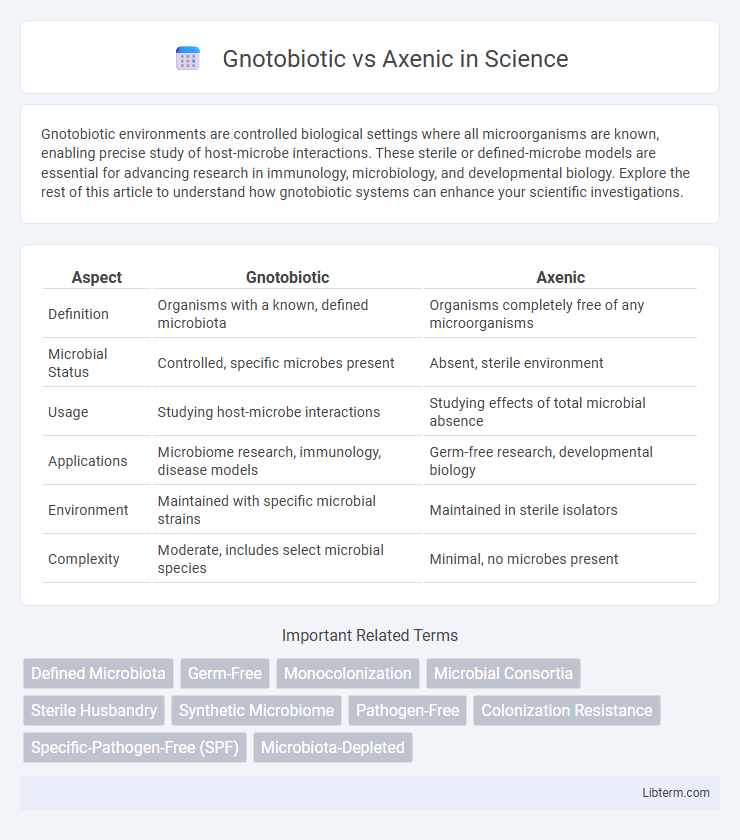Gnotobiotic environments are controlled biological settings where all microorganisms are known, enabling precise study of host-microbe interactions. These sterile or defined-microbe models are essential for advancing research in immunology, microbiology, and developmental biology. Explore the rest of this article to understand how gnotobiotic systems can enhance your scientific investigations.
Table of Comparison
| Aspect | Gnotobiotic | Axenic |
|---|---|---|
| Definition | Organisms with a known, defined microbiota | Organisms completely free of any microorganisms |
| Microbial Status | Controlled, specific microbes present | Absent, sterile environment |
| Usage | Studying host-microbe interactions | Studying effects of total microbial absence |
| Applications | Microbiome research, immunology, disease models | Germ-free research, developmental biology |
| Environment | Maintained with specific microbial strains | Maintained in sterile isolators |
| Complexity | Moderate, includes select microbial species | Minimal, no microbes present |
Introduction to Gnotobiotic and Axenic Systems
Gnotobiotic systems involve organisms with a known and controlled microbiota, allowing precise study of host-microbe interactions, while axenic systems refer to completely germ-free organisms free from all microorganisms. These experimental models are vital for understanding microbial influence on physiology, immunity, and disease development. Research using gnotobiotic and axenic systems enables controlled investigation of microbial contributions in health and biomedical science.
Definitions: Gnotobiotic vs Axenic
Gnotobiotic organisms are those with a known and controlled microbiota, meaning they harbor specific, identified microorganisms introduced intentionally under sterile conditions. Axenic organisms are completely free from any microorganisms, living in a sterile environment without any associated microbes. The primary distinction lies in gnotobiotic models having defined microbial populations, whereas axenic models are strictly microbe-free.
Historical Development and Significance
Gnotobiotic and axenic models trace back to early 20th-century microbiology, with axenic organisms representing completely germ-free entities, crucial for studying intrinsic biological processes without microbial influence. Gnotobiotic systems evolved by introducing known microbial communities to axenic hosts, enabling precise exploration of host-microbe interactions and microbial ecology. These models significantly advanced biomedical research, environmental science, and agricultural studies by elucidating microbial roles in health, disease, and ecosystem dynamics.
Methodologies for Establishing Axenic and Gnotobiotic Models
Axenic models are established through sterile techniques involving embryo transfer or cesarean delivery followed by rearing in germ-free isolators to maintain complete absence of microorganisms. Gnotobiotic models extend axenic protocols by introducing defined microbial communities or specific microbial strains into sterile hosts to study host-microbiota interactions. Both methodologies require rigorous sterilization, controlled environments, and continuous monitoring to ensure the integrity of microbial status in experimental animals.
Key Differences Between Gnotobiotic and Axenic Conditions
Gnotobiotic conditions involve organisms with a known and controlled microbiota, whereas axenic conditions refer to completely germ-free environments without any microorganisms. The key difference lies in microbial presence: gnotobiotic systems contain specific, introduced microbes, while axenic systems are entirely sterile. These distinctions critically impact research outcomes in microbiology, immunology, and host-microbiome interactions.
Applications in Microbiome Research
Gnotobiotic models, containing a known set of microorganisms, provide precise control over microbial variables in microbiome research, enabling detailed studies on host-microbe interactions and disease mechanisms. Axenic organisms, completely free of microbes, serve as essential controls to understand the intrinsic effects of microbes on host physiology and immune responses. Both models are critical for developing targeted probiotics, studying pathogen colonization, and elucidating microbial contributions to health and disease.
Advantages of Gnotobiotic Models
Gnotobiotic models offer precise control over microbial populations, enabling researchers to study specific host-microbiota interactions and their effects on health and disease. Unlike axenic models, which are completely germ-free, gnotobiotic systems allow the introduction of defined microbial communities, facilitating investigations into complex microbial functions and immune system development. These models enhance reproducibility and translational relevance in microbiome research, drug testing, and nutritional studies.
Limitations and Challenges of Axenic Systems
Axenic systems face significant limitations including the inability to mimic complex host-microbe interactions present in natural environments, which restricts the study of microbial ecology and immune system development. The complete absence of microorganisms can lead to abnormal physiological development and immune deficiencies in model organisms, impacting the translatability of research findings. Maintaining sterility in axenic environments is technically challenging and resource-intensive, often limiting the scalability and long-term sustainability of experiments.
Case Studies and Research Findings
Research findings in gnotobiotic and axenic models reveal crucial differences in microbial impact on host physiology and immunity. Case studies utilizing gnotobiotic animals demonstrate how specific microbial communities influence metabolic processes, immune development, and disease resistance, while axenic models, completely germ-free, establish baseline host responses without microbiota interference. Comparative analyses highlight the importance of microbial colonization in developing effective probiotic therapies and understanding pathogen-host interactions.
Future Perspectives and Innovations
Future perspectives in gnotobiotic and axenic research emphasize the integration of advanced genome editing techniques and single-cell analysis to precisely manipulate and characterize host-microbe interactions. Innovations in microfluidics and organ-on-a-chip technology enable more accurate modeling of microbial colonization and immune responses in controlled axenic environments. These approaches pave the way for personalized microbiome therapies and targeted interventions in infectious and chronic diseases.
Gnotobiotic Infographic

 libterm.com
libterm.com